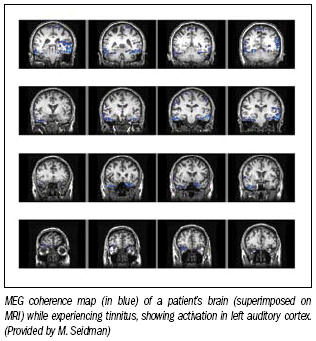MEG finds source of ringing in ears
Researchers in Michigan are using magnetoencephalography of the brain to identify the source of tinnitus, a chronic ringing or buzzing in the ears or inside one's head.
Researchers in Michigan are using magnetoencephalography of the brain to identify the source of tinnitus, a chronic ringing or buzzing in the ears or inside one's head. They are also using MEG to map tinnitus’ site or sites for neurointervention and to assess the effectiveness of treatment.
According to the American Tinnitus Association, about 12 million people in the U.S. deal with tinnitus symptoms that require medical attention. Two million become disabled by it. The factors that trigger tinnitus have been identified, but its underlying causes remain unknown.
Some imaging modalities, like PET, SPECT, or fMRI, have been used to investigate its source in the brain, but none find where it originates, said principal investigator Dr. Michael D. Seidman, director of otologic and neurotologic surgery at Henry Ford Hospital in Detroit. MEG provides a much better diagnostic tool, he said.

“We now have a technique that gives us more pinpoint accuracy of where the sound of tinnitus may be being generated by the brain,” Seidman told Diagnostic Imaging.
Seidman and colleagues enrolled 17 patients with tinnitus and 10 normal individuals who underwent MEG for 10 minutes while sheltered from external auditory and visual stimuli. The researchers subjected the data to coherence analysis to measure synchronized neural activity.
They found that in patients with unilateral tinnitus MEG detected an area no larger than 2 mm in diameter in the auditory cortex of the brain hemisphere opposite to the perceived tinnitus. Patients with bilateral tinnitus showed activity in both brain hemispheres, but one side was dominant. Seidman released his group’s findings Oct. 3 at the 2009 American Academy of Otolaryngology–Head and Neck Surgery Foundation meeting.
Seidman has used MEG to map suspicious sites in the brains of six patients who underwent treatment with a low electrical current that “jams” the noise. He also used MEG to monitor symptom reduction after intervention. Four of those patients have experienced symptom relief. Results are positive enough to recommend routine clinical MEG use, Seidman said.
“We are excited about the technique,” he said. “Obviously more refinement needs to occur, but I would certainly encourage other centers that have MEG to use it.”
New MRI Research Explores Links Between Waist-to-Hip Ratio and Memory in Aging
March 13th 2025Researchers found that a higher waist-to-hip ratio in midlife was associated with higher mean diffusivity in 26 percent of total white matter tracts in the cingulum as well as the superior and inferior longitudinal fasciculus.
Is MRI Contrast Enhancement Necessary for Long-Term Monitoring of Diffuse Glioma?
March 4th 2025In a comparison of contrast-enhanced T1-weighted (CET1w) MRI (and T2-weighted MRI/FLAIR imaging, researchers found that only three out of 82 cases of glioma progression were solely detected with CET1w MRI.